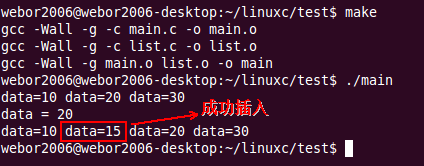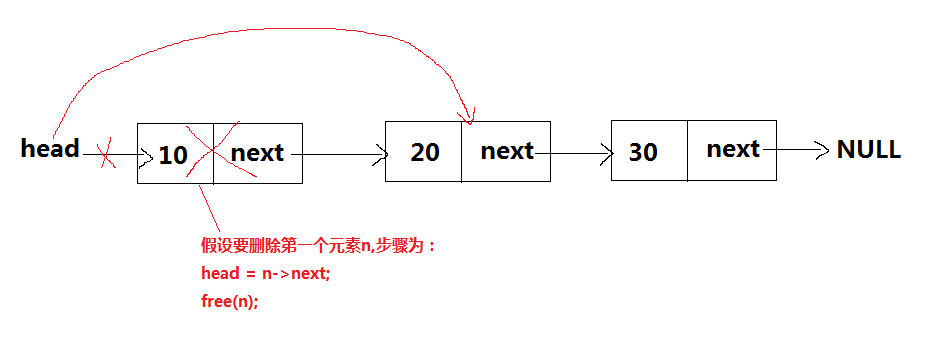今天继续完善自己的链表,上次已经实现了链表的插入、遍历、销毁方法,对于链表的插入,我们上次是在头结点进行插入的,这次,我们来实现一个在任意结点进行插入的方法。
实现链表的另外一种插入方法----在任意位置进行插入:
在实现它之前,先实现获取任意位置的结点的函数,为便在实现任意插入时会使用到它,先在头文件中定义:
list.h:
#ifndef _LIST_H_ #define _LIST_H_ #include <assert.h> typedef struct node { int data; struct node* next; } node_t; typedef void (*FUNC)(node_t*); node_t* list_insert_front(node_t* head, int data); void list_for_each(node_t* head, FUNC f); node_t* list_free(node_t* head); node_t* list_get_node(node_t* head, int index);//获取指定位置的结点 #endif /* _LIST_H_ */
具体实现list.c:
#include "list.h" #include <stdlib.h> node_t* list_insert_front(node_t* head, int data) { node_t* n = (node_t*)malloc(sizeof(node_t)); assert(n != NULL); n->data = data; n->next = NULL; if (head == NULL) head = n; else { n->next = head; head = n; } return head; } void list_for_each(node_t* head, FUNC f) { while (head) { f(head); head = head->next; } } node_t* list_free(node_t* head) { node_t* tmp; while (head) { tmp = head; head = head->next; free(tmp); } return head; } node_t* list_get_node(node_t* head, int index) { assert(index >= 0); int j = 0; while (head && j < index) { head = head->next; j++; } if (j == index)//说明已经找到结点 return head; return head;//说明最终head指向NULL,没有找到结点 }
上面的也可简写:
node_t* list_get_node(node_t* head, int index) { assert(index >= 0); int j = 0; while (head && j < index) { head = head->next; j++; } return head; }
测试一下:
main.c:
#include "list.h" #include <stdio.h> void print_node(node_t* n) { printf("data=%d ", n->data); } int main(void) { node_t* head = NULL; head = list_insert_front(head, 30); head = list_insert_front(head, 20); head = list_insert_front(head, 10); list_for_each(head, print_node); putchar(' '); node_t* n = NULL; n = list_get_node(head, 1); if (n != NULL) printf("data = %d ", n->data); else printf("not found "); head = list_free(head); assert(head == NULL); return 0; }
编译运行:

如果没有找到呢?
main.c:
int main(void) { node_t* head = NULL; head = list_insert_front(head, 30); head = list_insert_front(head, 20); head = list_insert_front(head, 10); list_for_each(head, print_node); putchar(' '); node_t* n = NULL; n = list_get_node(head, 5); if (n != NULL) printf("data = %d ", n->data); else printf("not found "); head = list_free(head); assert(head == NULL); return 0; }
编译运行:

好了,接着正式来定义任意插入的函数:
list.h:
#ifndef _LIST_H_ #define _LIST_H_ #include <assert.h> typedef struct node { int data; struct node* next; } node_t; typedef void (*FUNC)(node_t*); node_t* list_insert_front(node_t* head, int data); void list_for_each(node_t* head, FUNC f); node_t* list_free(node_t* head); node_t* list_get_node(node_t* head, int index); node_t* list_insert_at(node_t* head, int data, int index); #endif /* _LIST_H_ */
list.c:
#include "list.h" #include <stdlib.h> node_t* list_insert_front(node_t* head, int data) { node_t* n = (node_t*)malloc(sizeof(node_t)); assert(n != NULL); n->data = data; n->next = NULL; if (head == NULL) head = n; else { n->next = head; head = n; } return head; } void list_for_each(node_t* head, FUNC f) { while (head) { f(head); head = head->next; } } node_t* list_free(node_t* head) { node_t* tmp; while (head) { tmp = head; head = head->next; free(tmp); } return head; } node_t* list_get_node(node_t* head, int index) { assert(index >= 0); int j = 0; while (head && j < index) { head = head->next; j++; } return head; } node_t* list_insert_at(node_t* head, int data, int index) { assert(index >= 0); if (index == 0)//等于就是头插入结点,直接调用现成的方法 return list_insert_front(head, data); node_t* p; p = list_get_node(head, index - 1); if (p == NULL) { fprintf(stderr, "error insert pos "); exit(EXIT_FAILURE); }
//新建一个节点 node_t* n = (node_t*)malloc(sizeof(node_t)); assert(n != NULL); n->data = data; n->next = NULL;
//将节点进行链接 n->next = p->next; p->next = n; return head; }
说明:
①fprintf表示向什么地方输出,如fprintf(stdio,"hello!");等价于printf("hello!");
②exit()表示程序退出,参数EXIT_FAILURE代表错误退出,它还有另外一个宏定义EXIT_SUCCESS,代表成功退出
程序测试:
main.c:
#include "list.h" #include <stdio.h> void print_node(node_t* n) { printf("data=%d ", n->data); } int main(void) { node_t* head = NULL; head = list_insert_front(head, 30); head = list_insert_front(head, 20); head = list_insert_front(head, 10); list_for_each(head, print_node); putchar(' '); node_t* n = NULL; n = list_get_node(head, 1); if (n != NULL) printf("data = %d ", n->data); else printf("not found "); head = list_insert_at(head, 15, 1); list_for_each(head, print_node); putchar(' '); head = list_free(head); assert(head == NULL); return 0; }
编译:

其中的fprintf需要头文件:

所以在list.c中加入此头文件:

再次编译,运行:

如果插入失败会怎样呢?
#include "list.h" #include <stdio.h> void print_node(node_t* n) { printf("data=%d ", n->data); } int main(void) { node_t* head = NULL; head = list_insert_front(head, 30); head = list_insert_front(head, 20); head = list_insert_front(head, 10); list_for_each(head, print_node); putchar(' '); node_t* n = NULL; n = list_get_node(head, 1); if (n != NULL) printf("data = %d ", n->data); else printf("not found "); head = list_insert_at(head, 15, 5);//这个位置没有元素,应该会插入失败 list_for_each(head, print_node); putchar(' '); head = list_free(head); assert(head == NULL); return 0; }
编译运行:

实现链表的删除方法:
先定义删除方法:
list.h:
#ifndef _LIST_H_ #define _LIST_H_ #include <assert.h> typedef struct node { int data; struct node* next; } node_t; typedef void (*FUNC)(node_t*); node_t* list_insert_front(node_t* head, int data); void list_for_each(node_t* head, FUNC f); node_t* list_free(node_t* head); node_t* list_get_node(node_t* head, int index); node_t* list_insert_at(node_t* head, int data, int index); node_t* list_remove_at(node_t* head, int index); #endif /* _LIST_H_ */
具体实现,在实现前,先用一个简单的图来解释下:


具体实现如下list.c:
node_t* list_remove_at(node_t* head, int index) { assert(index >= 0); node_t* n; if (index == 0)//这是移除首结点 { n = head; head = head->next; free(n); } else { node_t* p = list_get_node(head, index - 1); if (p == NULL || p->next == NULL) { fprintf(stderr, "error remove pos "); exit(EXIT_FAILURE); } n = p->next; p->next = n->next; free(n); } return head; }
测试一下main.c:
#include "list.h" #include <stdio.h> void print_node(node_t* n) { printf("data=%d ", n->data); } int main(void) { node_t* head = NULL; head = list_insert_front(head, 30); head = list_insert_front(head, 20); head = list_insert_front(head, 10); list_for_each(head, print_node); putchar(' '); node_t* n = NULL; n = list_get_node(head, 1); if (n != NULL) printf("data = %d ", n->data); else printf("not found "); head = list_insert_at(head, 15, 1); list_for_each(head, print_node); putchar(' '); head = list_remove_at(head, 1); list_for_each(head, print_node); putchar(' '); head = list_free(head); assert(head == NULL); return 0; }
编译运行:

如果移除的元素不存在呢?
#include "list.h" #include <stdio.h> void print_node(node_t* n) { printf("data=%d ", n->data); } int main(void) { node_t* head = NULL; head = list_insert_front(head, 30); head = list_insert_front(head, 20); head = list_insert_front(head, 10); list_for_each(head, print_node); putchar(' '); node_t* n = NULL; n = list_get_node(head, 1); if (n != NULL) printf("data = %d ", n->data); else printf("not found "); head = list_insert_at(head, 15, 1); list_for_each(head, print_node); putchar(' '); head = list_remove_at(head, 5);//这个元素不存在,移除时会出错 list_for_each(head, print_node); putchar(' '); head = list_free(head); assert(head == NULL); return 0; }
运行:

实现链表的查找方法:
list.h:
#ifndef _LIST_H_ #define _LIST_H_ #include <assert.h> typedef struct node { int data; struct node* next; } node_t; typedef void (*FUNC)(node_t*); node_t* list_insert_front(node_t* head, int data); void list_for_each(node_t* head, FUNC f); node_t* list_free(node_t* head); node_t* list_get_node(node_t* head, int index); node_t* list_insert_at(node_t* head, int data, int index); node_t* list_remove_at(node_t* head, int index); node_t* list_find(node_t* head, int data, int* ret);//ret代表找到的链表的索引位置,返回值代表找到的链表结点 #endif /* _LIST_H_ */
list.c:
#include "list.h" #include <stdlib.h> #include <stdio.h> node_t* list_insert_front(node_t* head, int data) { node_t* n = (node_t*)malloc(sizeof(node_t)); assert(n != NULL); n->data = data; n->next = NULL; if (head == NULL) head = n; else { n->next = head; head = n; } return head; } void list_for_each(node_t* head, FUNC f) { while (head) { f(head); head = head->next; } } node_t* list_free(node_t* head) { node_t* tmp; while (head) { tmp = head; head = head->next; free(tmp); } return head; } node_t* list_get_node(node_t* head, int index) { assert(index >= 0); int j = 0; while (head && j < index) { head = head->next; j++; } return head; } node_t* list_insert_at(node_t* head, int data, int index) { assert(index >= 0); if (index == 0) return list_insert_front(head, data); node_t* p; p = list_get_node(head, index - 1); if (p == NULL) { fprintf(stderr, "error insert pos "); exit(EXIT_FAILURE); } node_t* n = (node_t*)malloc(sizeof(node_t)); assert(n != NULL); n->data = data; n->next = NULL; n->next = p->next; p->next = n; return head; } node_t* list_remove_at(node_t* head, int index) { assert(index >= 0); node_t* n; if (index == 0) { n = head; head = head->next; free(n); } else { node_t* p = list_get_node(head, index - 1); if (p == NULL || p->next == NULL) { fprintf(stderr, "error remove pos "); exit(EXIT_FAILURE); } n = p->next; p->next = n->next; free(n); } return head; } node_t* list_find(node_t* head, int data, int* ret) { *ret = -1; int i = 0; while (head) { if (head->data == data) { *ret = i; break; } head = head->next; i++; } return head; }
测试main.c:
#include "list.h" #include <stdio.h> void print_node(node_t* n) { printf("data=%d ", n->data); } int main(void) { node_t* head = NULL; head = list_insert_front(head, 30); head = list_insert_front(head, 20); head = list_insert_front(head, 10); list_for_each(head, print_node); putchar(' '); node_t* n = NULL; n = list_get_node(head, 1); if (n != NULL) printf("data = %d ", n->data); else printf("not found "); head = list_insert_at(head, 15, 1); list_for_each(head, print_node); putchar(' '); head = list_remove_at(head, 1); list_for_each(head, print_node); putchar(' '); int ret; n = list_find(head, 20, &ret); if (n != NULL) printf("data = %d index = %d ", n->data, ret); else printf("not found "); head = list_free(head); assert(head == NULL); return 0; }
编译,运行:

好了,今天的学习到这,关于链表,下次会再次进行完善,下次见。